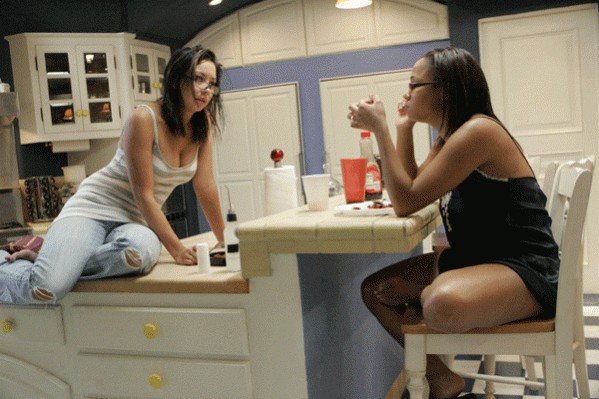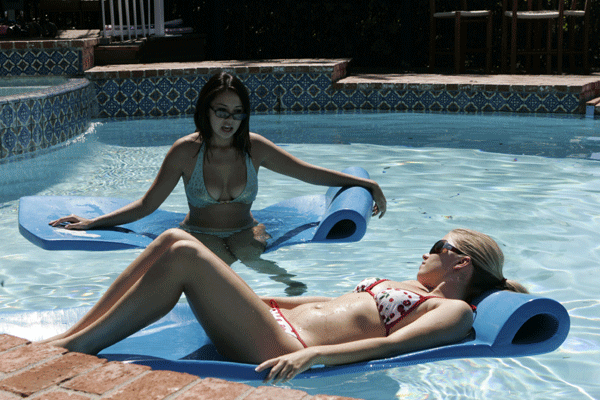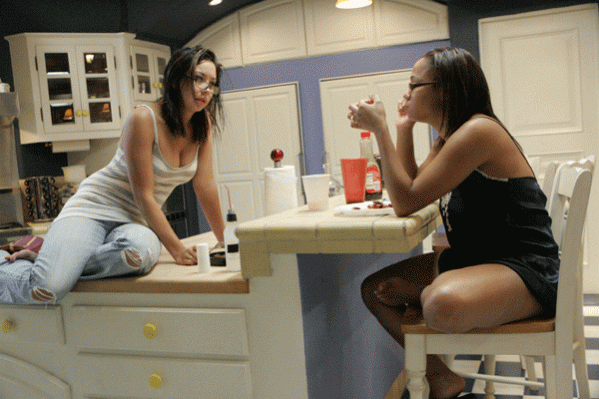
In the first of a two part series on how Final Cut Pro is being used in two of the biggest reality TV shops in the country, Mark Raudonis, VP, Post Production for Bunim Murray talks about the challenges of posting up to ten hours a week of finished programming.
With that much media moving through so many post-production steps, it’s critical to understand media management and to have a simple standard operating procedure that is followed throughout the process. Raudonis shares his hard-won knowledge of how to take advantage of Final Cut’s media management strengths and how to stay away from its weaknesses in this interview.
Q: Tell me about the hardware set-up over there.
Mark Raudonis: We run Apple’s XSAN shared storage system. We have two of them, actually. It’s a classic Apple designed installation with a primary and a secondary failover server and most clients connecting via fibre channel. The storage is Apple’s X-RAID, the fibre switches from QLogic, and the Ethernet connectivity is integrated into our regular IT infrastructure.
Q: And what are the seats?
MR: We used to be an “all Avid, all the time” shop up until about four and a half years ago, but now we’re all FCP everywhere. When we were a smaller company we rented all of our post gear, but then as we grew we were fortunate enough to be in a position to buy our own equipment. At that point we made the decision to go with Final Cut as opposed to Avid. We have three different kinds of “seats”: Off-line editing, story editing, and on-line editing/grfx/coloring. So, depending on which room you’re talking about we have either a full blown Mac Pro tower with two monitors, NTSC monitors, etc. or just a simple iMac.
Q: And how many seats are you running?
MR: It’s around 100, spread over two X-SANs in two different buildings. Not every seat is connected via fibre, however. Our story departments “reshare” via AFP over our regular gigE network.
Q: And how many shows are you producing in a given week/month or year?
MR: On average we’re doing anywhere between three to six shows simultaneously. And each of those shows may have anywhere from six to eight episodes in progress at a time. Most of those episodes are “hours”, so we’re probably pumping through three to ten hours per week of finished programming.

Q: How much time is spent on posting a show?
MR: It’s weeks in the off-line and probably like a week in on-line.
Q: What other apps are you running to do these shows?
MR: Adobe After Effects is probably the most used app aside from Final Cut. Many of our interviews are shot in front of a green screen and we’ve found that the keying in After Effects with Ultimatte’s “Advantage” plug in is unbeatable. Our GRFX designers also use AE for most of their design work as well. Our audio mixers use protocols.
Q: Can you describe a little bit about who the personnel are involved in posting the shows? Their responsibilities.
MR: The high volume of shows we produce requires a team approach to the post process, with people assigned to specific tasks. It starts with the digitizer. It’s an entry level job, but they need to know the basics of Final Cut, and more importantly, be very detail oriented. Then, you have an assistant editor who will coordinate the flow of material from production to post, organize the media on the SAN, and do basic media management. Our editors work very autonomously without a producer in the room, focusing on getting the story right. Depending on the nature of the show, our editors will coordinate with our grfx team for specific design elements like main titles, lower thirds and transition elements. Once the picture is locked, the project moves on to our on-line editor, colorist and audio mixers and. Finally, the delivery masters are cloned and captioned in our dub room.
Q: Are you using Color for color correction?
MR: Yes, we use “Color” whenever we can. We have six on-line rooms. They’re all equipped with the JLCooper Eclipse CX, scopes, monitors, etc. However, sometimes we’re working so close to deadline that we simply can’t lock picture soon enough to work with Color. In those cases we just use the Three Way (FCP’s built-in color correction effect). Our preference however is to use “Color” whenever possible.
Q: Do you use any software for media management: File Maker?
MR: We use a program called PilotWare for external logging, which is an independent logging program that lives on top of Filemaker Pro. So our logging teams will basically be working on PCs or Macs either to tape or to digital files and they will be logging everything that we shoot. It’s a massive amount of material. It’s a large number of people working at least two shifts a day. And they go through every frame that we shot.
Q: What is the standard operating procedure that the loggers and digitizers are using to handle media management?
MR: Media management is simple if you use common sense, and stay organized. For us, it starts with a simple reel numbering scheme during production. We make sure that everyone in production knows that scheme and sticks to it. With nearly 6500 tapes on any single show, it’s critical that every tape be labeled correctly. As for digitizing, we simply add a “red dot” to the tape label after it’s been digitized. Looking at all the masters on the shelf it’s very easy to spot what’s been digitized and what’s not.
Our loggers will add their initials to the tape label once they have logged the tape. As we move into a more file based workflow, some of these “physical” checks are being modified. For example, our logging program “Pilot ware” will have a metadata column for logger’s initials, or file based media will be backed up into a folder rather than put on a shelf with a red dot.
Many people “freak out” about media management, but the secret is to have a system and stick to it. Have a specific person designated as the conduit between post and production. Have a system in place for tracking shipments, checking in tapes, and monitoring the process. Most importantly, have enough digital storage to be flexible with your digitizing process. There’s nothing more frustrating or confusing than to have to “bounce” media from drive to drive due to space considerations. This frantic moving of media is often the root of media management problems later on. A dollar spent on extra storage up front will pay back ten when your project gets to the end and it grows to a size that no one ever anticipated.
Q: Are all assets going in to a specific place?
MR: We digitize local and move global. We do that for a couple reasons: convenience and organization. Working this way gives us another chance at getting it right before it goes public – before it goes on the SAN. You can pull out corrupt clips. You can make sure that the numbering system is correct and you can double check media before it goes up on the SAN – aspect ratios, that sort of thing. We also are bypassing Final Cut’s propensity to create a new Capture Scratch folder every time you start it up. Our editors never see something called Capture Scratch. It’s organized by show. Each show has a slightly different organization depending on what makes sense for that show. But sometimes we’ll organize by day of shooting. Other times by episode.
Q: So with no Capture Scratch, there’s just a folder for the show, and inside that are folders for days or episodes?
MR: Yes. On the Xsan you’ll have maybe six or eight root level folders. One will be “Real World” one will be “Runway” one will be “Kardashian” another one will be “Bad Girls.” These are all show names. And then once you navigate into that, you’ll have additional folders. One will say Media, one will say Editor Project backups. XSan uses Apple’s basic Finder level folder structure. Final Cut relies on basically the Mac OS to organize everything. So we set up a series of folder hierarchies that makes sense for that particular show. One of our goals is to be no more than four clicks from the edge. Meaning you don’t want to keep going from a folder inside of a folder, inside of a folder. There’s a point at which hyper-organization is counter productive. You want to be able to have an easy way to click three times and get to a piece of media.
Q: For someone who is just trying to manage their own media on their own gear, what are some of the tips that you would give them to make FCP work at its best.
MR: I would ignore the Capture Scratch function of Final Cut and before you start editing, move everything to a logical folder. So right now, Final Cut creates something called Capture Scratch. I would make the workflow rule that whenever I’m digitizing, I’m going to digitize to a “digitize only” project and use that to gather the material and then move that immediately to whatever I’m working on: Project x, y or z. So I would say that’s the number one trick: to not let Final Cut organize the media for you and do it yourself in a more controlled folder hierarchy that makes sense. It’s even easier if you’re a one-man because I would assume if you’re doing it yourself as a one-man band, you’re going to have a lot of different projects in play simultaneously and it’s hard to tell on a media basis alone where something belongs, so move it to a project folder that makes sense and adopt a logical naming scheme and stick to it. DO NOT RENAME YOUR CLIPS. Do not succumb to the temptation of renaming your clips. It’s not an Avid. You can’t rename your clip “CU Guy walks in door.” That will totally hose any efforts to organize your media. That Media Management 101.
Q: And what is your naming scheme that you hand down to your digitizers for your clips?
MR: It’s nothing fancy. It’s a show name and an abbreviation “Real World”: RW, “Project Runway”: PR, “Bad Girls”: BG. A couple letter designator for the show. The date, October 20th: 1020. A camera designator: A camera, B camera, C camera, D camera. And then a load number. So if we were shooting this as an interview and there were two cameras, since this is Provideo: PV1_1020A01, meaning the first load of the A camera. And then your side would be PV1_1020B02.
Sometimes, an editor will complain “I’m not organized. I’m creative.” And what I say to that is “bunk!!!”. If you can’t find what you’re looking for, you can’t be creative. So organization is the key to creativity. And even if you’re rushed for time there’s no excuse for not doing it right.
Q: And what do you do about elements that are used across episodes.
MR: There will be a folder in each episode that will have common elements and usually those are graphics or main title sequence or end credits, partner logos, things like that, network logos, bugs. Those things are in a folder labeled “graphics” and everyone has access to that. And that’s a prime example of why you want to organize things so well.
Q: Any other advice?
MR: Final Cut, unlike Avid has the ability to have multiple projects open simultaneously. Many editors coming from an Avid background don’t seem to grasp this concept and use it to their advantage. We’ve found that if you have very large projects, especially with multi-cam, performance will suffer. So one of the things to think about when organizing a lot of media is how can you break all that media into separate designated projects: for example b-roll, or music, or interviews.
While editing, an editor may have five or six different projects open simultaneously. By organizing your media this way, you’re really leveraging the “entire SAN” as your project. FCP helps you do this with their “reveal in finder” key.
Q: Is that dangerous when you get in to on-line? How does that scheme translate?
MR: It’s not dangerous, if you follow one basic rule: Don’t rename your filenames (clip name). The notion that “the SAN is the project” opens up the whole concept of media management to a much larger, company wide level. You can easily have access to anything on the entire SAN. We now use the “Coverflow” feature found in Mac’s OS to browse media. (Coverflow was created for the iPod & iTunes to shuffle through “cover art” while choosing a song)
Media management doesn’t have to be painful, or frustrating. A logical folder structure can make even the largest projects easy to navigate, and therefore, easy to work with.


